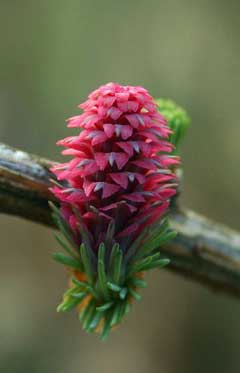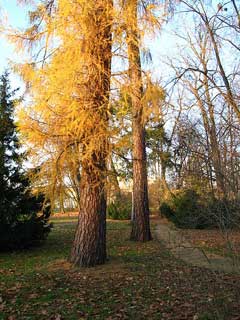 |
|
http://commons.wikimedia.org/wiki/User:Pleple2000 |
 |
| http://commons.wikimedia.org/wiki/User:Crusier |
Translate this page:
Summary
Bloom Color: Red, Yellow. Main Bloom Time: Early spring, Late spring, Mid spring. Form: Pyramidal.
Physical Characteristics

 Larix decidua is a deciduous Tree growing to 45 m (147ft) by 15 m (49ft) at a fast rate.
Larix decidua is a deciduous Tree growing to 45 m (147ft) by 15 m (49ft) at a fast rate.
See above for USDA hardiness. It is hardy to UK zone 4 and is not frost tender. It is in flower from April to May, and the seeds ripen from October to November. The species is monoecious (individual flowers are either male or female, but both sexes can be found on the same plant) and is pollinated by Wind.
Suitable for: light (sandy) and medium (loamy) soils, prefers well-drained soil and can grow in nutritionally poor soil. Suitable pH: mildly acid, neutral and basic (mildly alkaline) soils and can grow in very acid soils.
It cannot grow in the shade. It prefers moist soil. The plant can tolerate maritime exposure.
It cannot tolerate atmospheric pollution.
UK Hardiness Map
US Hardiness Map
Synonyms
Larix europaea. Larix communis. Abies larix. Pinus larix.
Plant Habitats
Woodland Garden Canopy;
Edible Uses
Edible Parts: Inner bark Manna
Edible Uses:
Inner bark - it can be eaten raw or can be dried, ground into a powder and used with cereal flours in making bread etc[2, 177]. A sweet-tasting manna is obtained from the trunk, it can be eaten raw but is mainly used medicinally[2, 7, 46, 61, 105]. Another report says that 'Briancon manna' is exuded from the leaves in the summer[4]. It is white, sweet and almost odourless[4].
References More on Edible Uses
Medicinal Uses
Plants For A Future can not take any responsibility for any adverse effects from the use of plants. Always seek advice from a professional before using a plant medicinally.
Anthelmintic Antidote Antirheumatic Antiseptic Astringent Bach Balsamic Diuretic
Eczema Expectorant Haemostatic Laxative Rubefacient Stimulant Vermifuge
Vulnerary
The bark, stripped of its outer layer, is astringent, balsamic, diuretic, expectorant, stimulant and vulnerary[4, 21]. Its main application is as an expectorant in chronic bronchitis and has also been given internally in the treatment of haemorrhage and cystitis[4, 238]. A cold extract of the bark is used as a laxative[9]. As an external application, it is useful in the treatment of chronic eczema and psoriasis[4]. The powdered bark can be used on purulent and difficult wounds to promote their healing[21]. The bark is harvested in the spring and should be dried rapidly[4]. The turpentine obtained from the resin is antiseptic, balsamic, diuretic, haemostatic, rubefacient and vermifuge[4, 238]. It is a valuable remedy in the treatment of kidney, bladder and rheumatic affections, and also in diseases of the mucous membranes and the treatment of respiratory complaints[4]. Other reports say that it is contraindicated for anyone with a kidney complaint[7, 238]. Externally, the turpentine is used in the form of liniment plasters and inhalers[4]. It has also been suggested for combating poisoning by cyanide or opium[4]. The plant is used in Bach flower remedies - the keywords for prescribing it are 'Lack of confidence', 'Anticipation of failure' and 'Despondency'[209]. The German Commission E Monographs, a therapeutic guide to herbal medicine, approve Larix decidua for fevers & colds, coughs/bronchitis, tendency to infection, blood pressure problems, inflammation of mouth and pharynx, common cold (see [302] for critics of commission E).
References More on Medicinal Uses
The Bookshop: Edible Plant Books
Our Latest books on Perennial Plants For Food Forests and Permaculture Gardens in paperback or digital formats.

Edible Tropical Plants
Food Forest Plants for Hotter Conditions: 250+ Plants For Tropical Food Forests & Permaculture Gardens.
More

Edible Temperate Plants
Plants for Your Food Forest: 500 Plants for Temperate Food Forests & Permaculture Gardens.
More

More Books
PFAF have eight books available in paperback and digital formats. Browse the shop for more information.
Shop Now
Other Uses
Pioneer Resin Tannin Wood
Large quantities of resin are obtained by tapping the trunk[4]. Small holes are bored into the trunk, most resin being obtained from near the centre of the trunk[171]. When properly made, the same borehole can be used for 20 - 30 years[64]. The resin has a wide range of uses including wood preservatives, varnish, medicinal etc[4, 64]. It needs no preparation other than straining through a cloth to remove plant debris etc[4]. The hole is made in the spring and the resin extracted in the autumn[64]. Resin can be extracted from May to October[4]. The yield is about 40 grams per tree[64]. A fast-growing tree that establishes itself rapidly and is also said to improve the quality of the soil, the larch can be used as a pioneer species on cleared and exposed land in order to assist the establishment of other woodland trees[4]. The bark contains tannin[171]. This is much utilized in N. Europe[223], though in Britain the oak is considered to be a better source[4]. On a 10% moisture basis, the bark contains 11.6% tannin[223]. Wood - durable, tough, elastic, easy to split, takes a good polish[4, 46, 61, 81]. Larch produces one of the toughest woods obtained from conifers and is also resistant to woodworm[4]. It is widely used in construction, for railway sleepers, cabinet work etc[4, 46, 61, 81].
Special Uses
Food Forest Scented Plants
References More on Other Uses
Cultivation details
Landscape Uses:Specimen. Prefers an open airy position in a light or gravelly well-drained soil[11, 200]. It tolerates acid and infertile soils, though it dislikes very peaty or very chalky soils[11]. Another report says that it tolerates chalky soils[200]. Succeeds on rocky hill or mountain sides and slopes[200]. Tolerates salt-laden gales according to one report[75] whilst another says that it dislikes exposed positions[11]. The larch dislikes atmospheric pollution and so does not grow well in towns[185]. A north or east aspect is more suitable than west or south[11]. It dislikes growing in wet ground or frost pockets[11, 81], and grows best in areas with abundant rainfall[11]. The larch is a very ornamental tree that is widely grown for forestry[11, 81]. It is very fast growing with new annual growth of 1.5 metres often found and trees can average 60cm or more for many years[185]. The dormant trees are very cold hardy, but they are often excited into premature growth in Britain by mild spells during the winter, the plants are then subject to damage by late frosts and cold winds[1, 185]. The young shoots have a delicate mossy fragrance as the leaves unfold[245]. Hybridizes freely with other members of this genus. Open ground plants, 1 year x 1 year are the best for planting out, do not use container grown plants with spiralled roots[200]. Plants transplant well, even when coming into growth in the spring[200]. Plants in this genus are notably resistant to honey fungus[81, 200]. Special Features:Not North American native, Attractive flowers or blooms.
References Carbon Farming Information and Carbon Sequestration Information
Temperature Converter
Type a value in the Celsius field to convert the value to Fahrenheit:
Fahrenheit:
The PFAF Bookshop
Plants For A Future have a number of books available in paperback and digital form. Book titles include Edible Plants, Edible Perennials, Edible Trees,Edible Shrubs, Woodland Gardening, and Temperate Food Forest Plants. Our new book is Food Forest Plants For Hotter Conditions (Tropical and Sub-Tropical).
Shop Now
Plant Propagation
Seed - sow late winter in pots in a cold frame. One months cold stratification helps germination[113]. It is best to give the seedlings light shade for the first year[78]. As soon as they are large enough to handle, prick out the seedlings into individual pots. Although only a few centimetres tall, they can be planted out into their permanent positions in the summer providing you give them an effective weed-excluding mulch and preferably some winter protection for their first year. Otherwise grow them on in the cold frame for their first winter and plant them out in early summer of the following year. The seed remains viable for 3 years[113] If you are growing larger quantities of plants, you can sow the seed in an outdoor seedbed in late winter. Grow on the seedlings in the seedbed for a couple of years until they are ready to go into their permanent positions then plant them out during the winter.
Other Names
If available other names are mentioned here
Native Range
EUROPE: Austria, Switzerland, Czech Republic, Germany (south), Liechtenstein, Poland, Slovakia, Ukraine (northwest), Italy (north), Montenegro, Romania, Slovenia, France (southeast)
Weed Potential
Right plant wrong place. We are currently updating this section.
Please note that a plant may be invasive in one area but may not in your area so it's worth checking.
Conservation Status
IUCN Red List of Threatened Plants Status :

Growth: S = slow M = medium F = fast. Soil: L = light (sandy) M = medium H = heavy (clay). pH: A = acid N = neutral B = basic (alkaline). Shade: F = full shade S = semi-shade N = no shade. Moisture: D = dry M = Moist We = wet Wa = water.
Now available:
Food Forest Plants for Mediterranean Conditions
350+ Perennial Plants For Mediterranean and Drier Food Forests and Permaculture Gardens.
[Paperback and eBook]
This is the third in Plants For A Future's series of plant guides for food forests tailored to
specific climate zones. Following volumes on temperate and tropical ecosystems, this book focuses
on species suited to Mediterranean conditions—regions with hot, dry summers and cool, wet winters,
often facing the added challenge of climate change.
Read More
Expert comment
Author
Mill.
Botanical References
11200
Links / References
For a list of references used on this page please go here
Readers comment